After four days in the hospital, I had reached the point where all I really required was physical therapy in addition to basic human needs. So on the morning of the fifth day, my wife drove off to inspect a few Inpatient Rehab facilities. She was back by 10:00 a.m., proudly declaring that she had found the ideal place. But there was just one little unpleasant detail.
It seems that in Florida, there’s no such thing as an Inpatient Rehab center. Instead, there are nursing homes that have a resident physical therapist. Nursing homes love to fill a bed with a temporary rehab client, because insurance companies pay them far more than the Social Security of the other residents (who are also temporary).
Still, I didn’t see a downside. I’ve been inside nursing homes before. Yes, they’re depressing. Yes, they sometimes abuse the residents. But nobody was going to abuse me, and I was anxious to get started on a focused program of exercise so that I could get up out of bed and walk.
I had my wife pack my belongings, and I was ready to go by noon. But for some reason, it took a long time to arrange the transfer. For one thing, they had to schedule an ambulance pickup, because my wife had an appointment and was unavailable to drive me. “Ambulance?” I sputtered. “Why not call a cab? It’s only 5 exits away!” But for some reason, hospitals don’t work that way.
So I sat, fuming and dithering until 6 p.m., when the ambulance arrived with three attendants. One was a snotty and officious small man who liked to bark orders, another was an older guy who had found retirement too boring, and then there was the stoner.
The three of them lifted me on a sheet and slid me onto the gurney. While buckling me in, the older guy leaned across my body and set his elbow down exactly on my left-knee incision. He apologized profusely, declaring that he of all people should have known better.
They wheeled me out of the hospital into the blazing afternoon heat, and loaded me into the ambulance, which was like an oven inside. The stoner sat in the back with me, trying to connect me to a battery-powered device that measures pulse rate and blood oxygen level. The device kept shutting off, and the stoner would respond by smacking it with the heel of his hand until it lit up again. However, the numbers were screwy and unreliable, so after a few more smacks he stuck an oxygen hose in my nose “just in case.”
“I’m not an accident victim,” I told him. “My blood oxygen is fine.”
“Yeah, but I can’t confirm that with this thing,” he explained, waving the sporadically-blinking box. “Better safe than sorry.”
The ambulance, which has the exact same suspension system as that of a dump truck, bounced and rattled up the interstate, sending my knees into spasms of pain. I hadn't anticipated this problem, and hadn’t taken a pain pill since 9 a.m. By the time we arrived, I was writhing.
The attendants slid me out of the ambulance, lowered the wheels to the ground, and tilted the gurney so that my feet were lower than my head. It felt like I was floating six feet in the air. A small crowd of wheelchair-bound residents gaped in wonder and delight at my arrival, waving and smiling toothless smiles. I felt a strange euphoria, like a rock star, threading my way in a limo through crowds of groupies outside the stage entrance. It must have been all that extra oxygen.
Saturday, July 31, 2010
Friday, July 30, 2010
Recovery Ward
In the hospital, time quickly lost all meaning. I had a clock and a window to mark the passing of hours and days, but hospitals run around the clock.
Sleep was only possible in short, sporadic increments, because something was always going on. Thanks to my passing-out episode, the doctors decided to conduct numerous tests to eliminate the possibility that I had suffered a stroke, heart attack or embolism. This meant that someone came in frequently to take my blood pressure, pulse and temperature, and I had to give blood samples daily. Before long, I had track marks all over both arms.
However, the nurse presented me with the World’s Third-Greatest Invention. First is fire. Second is the wheel. Third is the bedside urinal. There was a bathroom in my room, but it might as well have been in orbit around Saturn. I never saw the inside of it.
Once the nurse removed my catheter, I was given instructions to drink water as often as I could. I quickly became adept at using the urinal, except for the times that I was strapped in to the mechanical leg benders. Then it was like trying to shoot a target from a moving horse.
Every couple of hours, a nurse would come in and pick up the urinal. She’d swish it around and hold it up to the light to check the color, clarity and quantity like a sommelier, and then she’d empty it for me. I kept thinking how funny it would be if she were to say something like, “Hmm. You had fun in college, didn’t you?”
I have to say that the nurses were all smart, cheerful, and professional, and they’d materialize within seconds to attend to my every need when I pressed the Call button. Whenever the shift changed, the duty nurse would come in with his or her replacement and introduce them, which was nice touch.
Meals were delivered to my bed, and they were all of uniform quality. Not good, not bad, but you wouldn’t want to have to eat it every day. Fortunately, I didn’t have much of an appetite.
My only genuine criticism of hospital operations was that physical therapy was kind of basic and haphazard. I was strapped in to the mechanical leg benders every day for six hours at a stretch, which is just too long. Also, once every day (never at the same time of day), two physical therapists would hoist me onto the walker for a short, excruciating shuffle. The biggest problem was that no attempt was made to coordinate the strenuous activities with doses of pain medication. Sometimes I was properly medicated; other times I was not.
I was in the hospital for five days. By the fifth day, I could walk with assistance up and down the hospital corridor on the walker, which seemed like astonishing progress. I was eager to begin a genuine physical therapy program, so we discussed the two options with the hospital social worker. One option was Home Health Care, where a nurse and a physical therapist provide services to the patient at home. The other option was Inpatient Rehab, where the patient is given a bed, meals and other services in addition to nursing and physical therapy. We chose Inpatient Rehab, because at that point, caring for me would be a huge effort for my wife, especially if it involved moving me.
We chose wrong, as you’ll see in my next post.
Sleep was only possible in short, sporadic increments, because something was always going on. Thanks to my passing-out episode, the doctors decided to conduct numerous tests to eliminate the possibility that I had suffered a stroke, heart attack or embolism. This meant that someone came in frequently to take my blood pressure, pulse and temperature, and I had to give blood samples daily. Before long, I had track marks all over both arms.
However, the nurse presented me with the World’s Third-Greatest Invention. First is fire. Second is the wheel. Third is the bedside urinal. There was a bathroom in my room, but it might as well have been in orbit around Saturn. I never saw the inside of it.
Once the nurse removed my catheter, I was given instructions to drink water as often as I could. I quickly became adept at using the urinal, except for the times that I was strapped in to the mechanical leg benders. Then it was like trying to shoot a target from a moving horse.
Every couple of hours, a nurse would come in and pick up the urinal. She’d swish it around and hold it up to the light to check the color, clarity and quantity like a sommelier, and then she’d empty it for me. I kept thinking how funny it would be if she were to say something like, “Hmm. You had fun in college, didn’t you?”
I have to say that the nurses were all smart, cheerful, and professional, and they’d materialize within seconds to attend to my every need when I pressed the Call button. Whenever the shift changed, the duty nurse would come in with his or her replacement and introduce them, which was nice touch.
Meals were delivered to my bed, and they were all of uniform quality. Not good, not bad, but you wouldn’t want to have to eat it every day. Fortunately, I didn’t have much of an appetite.
My only genuine criticism of hospital operations was that physical therapy was kind of basic and haphazard. I was strapped in to the mechanical leg benders every day for six hours at a stretch, which is just too long. Also, once every day (never at the same time of day), two physical therapists would hoist me onto the walker for a short, excruciating shuffle. The biggest problem was that no attempt was made to coordinate the strenuous activities with doses of pain medication. Sometimes I was properly medicated; other times I was not.
I was in the hospital for five days. By the fifth day, I could walk with assistance up and down the hospital corridor on the walker, which seemed like astonishing progress. I was eager to begin a genuine physical therapy program, so we discussed the two options with the hospital social worker. One option was Home Health Care, where a nurse and a physical therapist provide services to the patient at home. The other option was Inpatient Rehab, where the patient is given a bed, meals and other services in addition to nursing and physical therapy. We chose Inpatient Rehab, because at that point, caring for me would be a huge effort for my wife, especially if it involved moving me.
We chose wrong, as you’ll see in my next post.
Friday, July 23, 2010
The Pain Scale
Throughout the recovery process, I’m constantly being asked to rate my pain on a 0 – 10 scale. But they always ask me to define “10” as “the worst pain you’ve ever felt.” It seems too subjective to me, because a “10” for a guy who has never given birth might seem like a “4” to a woman who has.
By the second day after surgery, the anesthesia had mostly worn off. The nurse gave me a gizmo that looked like a bong and told me to suck on it, trying to keep a floating yellow bead between two markers. Supposedly, this would open my lungs and expel the remainder of the anesthesia. “Do that ten times an hour,” she said, and left. Ten times? Every hour? Maybe this thing is a bong.
Later that day, the physical therapists returned to get me up on the walker again. I gritted my teeth for the effort, and was extremely displeased to discover that without the benefit of lingering anesthesia, the pain was easily double that of the previous attempt. One of the therapists kept insisting that I “breathe” and “keep my eyes open” as I gasped and moaned, shuffling over to the chair beside the bed.
Sweating and shuddering from the pain, I waited for the inevitable trip back, the physical therapists constantly asking me to rate my pain. “That was a nine,” I sobbed, believing that a ten would be so intolerable, I’d never live to describe it.
Within a few minutes, the physical therapists hoisted me to my feet again. My head swam from the searing pain. My eyes clouded with floating multicolored spots, and off in the distance, I could hear one of the therapists insisting that I breathe. I was able to blurt out the words, “I’m going to pass out.”
I came to on the bed, one of the therapists waving something under my nose that looked like a paint chip, but which had no discernable odor. After that episode, the physical therapists still visited me every day, but took a far less aggressive approach to getting me up on the walker.
The next day, I was visited by a nurse who told me they were going to remove the “drains” from my incisions. These are small tubes designed to divert any body fluids to collection bags outside the body, preventing them from pooling up inside the incision. “This is going to hurt,” she told me. And it sure did. Maybe a 7. Piece of cake.
“Let me dispose of these,” she said, coiling up the tubes, “and I’ll come back and remove your catheter.”
My what? I groped beneath the blankets and discovered the tube coming out of my penis. How could I not know it was there? How did it get in there?
The nurse returned, and started handling my private parts with practiced professionalism. “Ready?” she asked. On a pain scale, it was about a 4. I’ll spare you the grotesque imagery of the procedure, but I will say that I wish to God I hadn't watched.
By the second day after surgery, the anesthesia had mostly worn off. The nurse gave me a gizmo that looked like a bong and told me to suck on it, trying to keep a floating yellow bead between two markers. Supposedly, this would open my lungs and expel the remainder of the anesthesia. “Do that ten times an hour,” she said, and left. Ten times? Every hour? Maybe this thing is a bong.
Later that day, the physical therapists returned to get me up on the walker again. I gritted my teeth for the effort, and was extremely displeased to discover that without the benefit of lingering anesthesia, the pain was easily double that of the previous attempt. One of the therapists kept insisting that I “breathe” and “keep my eyes open” as I gasped and moaned, shuffling over to the chair beside the bed.
Sweating and shuddering from the pain, I waited for the inevitable trip back, the physical therapists constantly asking me to rate my pain. “That was a nine,” I sobbed, believing that a ten would be so intolerable, I’d never live to describe it.
Within a few minutes, the physical therapists hoisted me to my feet again. My head swam from the searing pain. My eyes clouded with floating multicolored spots, and off in the distance, I could hear one of the therapists insisting that I breathe. I was able to blurt out the words, “I’m going to pass out.”
I came to on the bed, one of the therapists waving something under my nose that looked like a paint chip, but which had no discernable odor. After that episode, the physical therapists still visited me every day, but took a far less aggressive approach to getting me up on the walker.
The next day, I was visited by a nurse who told me they were going to remove the “drains” from my incisions. These are small tubes designed to divert any body fluids to collection bags outside the body, preventing them from pooling up inside the incision. “This is going to hurt,” she told me. And it sure did. Maybe a 7. Piece of cake.
“Let me dispose of these,” she said, coiling up the tubes, “and I’ll come back and remove your catheter.”
My what? I groped beneath the blankets and discovered the tube coming out of my penis. How could I not know it was there? How did it get in there?
The nurse returned, and started handling my private parts with practiced professionalism. “Ready?” she asked. On a pain scale, it was about a 4. I’ll spare you the grotesque imagery of the procedure, but I will say that I wish to God I hadn't watched.
Introduction to Medical Equipment
Coming out of general anesthesia is always interesting, although not always pleasant. The symptoms differ depending on the drugs employed. I’ve only experienced it twice. This time, I had a problem with eye roll. It was like an old TV set with a broken vertical hold. Faces of nurses and doctors just floated up from the bottom of my visual field and disappeared off the top.
I was given a button connected to a morphine pump. They told me that every six minutes, I could push the button to deliver a tiny amount of morphine my bloodstream. But because of the anesthesia, I wasn’t remembering instructions very well. My wife broke the rules by taking control of the button to keep my pain under control.
After several hours of fading in and out of consciousness, my surgeon came in and asked if I wanted to try to stand on the new replacement knees. Seriously, doc – would you? I think they phrase it like that so it seems as though it was all your idea.
Nurses gathered up the wires and tubes connecting me to various appliances in the room, two physical therapists held me under the armpits, and lifted me to a standing position behind a walker, which I grasped like a drowning man.
People seem curious about the pain. It was blinding, overwhelming, stunning. But it wasn’t the worst pain I have ever felt; I wouldn’t experience that until the following day.
There was a reclining chair adjacent to the hospital bed, and the P/Ts coached me through a heavily-assisted 90-degree turn, and then I was directed to sit in the chair. I plopped down, gasping from the pain and the effort, and was allowed to rest there for two hours. Then, the P/Ts rejoined me for the return trip to the bed.
It was much worse getting up that second time, because every cell in my body knew what was coming. I cursed and sweated, struggling that three feet back to the bed.
After another short rest, the staff introduced me to four pieces of equipment that I shall hate for the rest of my life. I call them the “squeezers,” the “freezers,” the “straighteners” and the “benders.”
I was given a button connected to a morphine pump. They told me that every six minutes, I could push the button to deliver a tiny amount of morphine my bloodstream. But because of the anesthesia, I wasn’t remembering instructions very well. My wife broke the rules by taking control of the button to keep my pain under control.
After several hours of fading in and out of consciousness, my surgeon came in and asked if I wanted to try to stand on the new replacement knees. Seriously, doc – would you? I think they phrase it like that so it seems as though it was all your idea.
Nurses gathered up the wires and tubes connecting me to various appliances in the room, two physical therapists held me under the armpits, and lifted me to a standing position behind a walker, which I grasped like a drowning man.
People seem curious about the pain. It was blinding, overwhelming, stunning. But it wasn’t the worst pain I have ever felt; I wouldn’t experience that until the following day.
There was a reclining chair adjacent to the hospital bed, and the P/Ts coached me through a heavily-assisted 90-degree turn, and then I was directed to sit in the chair. I plopped down, gasping from the pain and the effort, and was allowed to rest there for two hours. Then, the P/Ts rejoined me for the return trip to the bed.
It was much worse getting up that second time, because every cell in my body knew what was coming. I cursed and sweated, struggling that three feet back to the bed.
After another short rest, the staff introduced me to four pieces of equipment that I shall hate for the rest of my life. I call them the “squeezers,” the “freezers,” the “straighteners” and the “benders.”
- The squeezers are two air bladders that are wrapped around each lower leg. A small pump inflates one, which tightens around the leg briefly, and is then deflated. The process is repeated on the other leg, alternating all night long. The purpose of this device is to keep the blood moving on bedridden patients to prevent blood clots. But the truth is that the bladders rub on the skin a little bit when they inflate, over and over, until you want to scream.
- The freezers are four pads about the size of ping-pong paddles, connected through a series of hoses to small refrigeration units. Two pads are placed on either side of each knee, and refigerated liquid is pumped through them all night long. They reduce swelling, but they also refrigerate the blood of the patient. I suffered from painful bouts of uncontrollable shivering, despite being covered with five blankets.
- The straighteners are reinforced wraps that cover the entire leg, preventing it from bending. These are strapped on all night, to prevent involuntary movements that might disrupt the healing process. They’re horrible, because they pretty much prevent every other kind of movement, voluntary or not.
- The benders are machines that slowly bend the leg to a programmable angle, over and over again, up to six hours a day on each leg. There are several designs for these machines, but in my experience, the best ones are those that have no scrotum-pinching parts.
Wednesday, July 21, 2010
Surgery
It starts with a subtle realization that you can’t walk or run as far as you used to. You make excuses, “I’m not a kid anymore,” or “I’m not in such a big hurry.” And then, one day, your wife asks you to take a long walk on the beach.
OK, I’ve always hated long walks on the beach for two reasons:
So last Thursday, I found myself lying on a hospital gurney in the surgical prep area of major local hospital. Tubes and wires stuck into me everywhere, and a petite young woman was busily shaving my legs in preparation for knee replacement surgery. I have lots of stories about this experience. Not all of them will be funny. Some are icky.
This one starts just a little icky.
After my legs had been completely shaved, I asked the nurse if it was too late for me to attempt a bowel movement. I hadn’t had my normal morning cup of coffee, because I had been forbidden to eat or drink anything for the last 7 hours. This had thrown me off schedule, and despite my best efforts, I was unsuccessful. I would remain unsuccessful for six days, because anesthesia and pain medication can result in miserable constipation.
Returning in defeat to the gurney, I was visited by my surgeon. About 12 years ago, when my daughter was in first grade, we met a lot of parents, some of whom were outside of our social strata. But we socialized with them anyway, because our kids liked each other, resulting in lots of birthday parties and other get-togethers. My surgeon was one of those parents. I don’t like him, personally – but he’s the best, so I hired him.
He walked away making some notes, and another man about the same age approached, dressed in surgical scrubs. He stepped forward and introduced himself as my anesthesiologist. I suddenly realized that he was the father of yet another of my daughter’s first-grade friends. I’ve been to his house and enjoyed his beer. It was a strange moment as we sheepishly caught up. Later, as my wife entered the building to join me, she ran into an oncologist who was the father of still another of my daughter’s first-grade friends.
Anyway, that’s all I remember until I woke up in recovery 3 hours later, with throbbing knees, a sore throat and a tube coming out of my penis.
OK, I’ve always hated long walks on the beach for two reasons:
- The beach is the same a mile from where I am now.
- Long walks on the beach only sound romantic; real romance is inside you, a very short walk if you know where you’re going.
So last Thursday, I found myself lying on a hospital gurney in the surgical prep area of major local hospital. Tubes and wires stuck into me everywhere, and a petite young woman was busily shaving my legs in preparation for knee replacement surgery. I have lots of stories about this experience. Not all of them will be funny. Some are icky.
This one starts just a little icky.
After my legs had been completely shaved, I asked the nurse if it was too late for me to attempt a bowel movement. I hadn’t had my normal morning cup of coffee, because I had been forbidden to eat or drink anything for the last 7 hours. This had thrown me off schedule, and despite my best efforts, I was unsuccessful. I would remain unsuccessful for six days, because anesthesia and pain medication can result in miserable constipation.
Returning in defeat to the gurney, I was visited by my surgeon. About 12 years ago, when my daughter was in first grade, we met a lot of parents, some of whom were outside of our social strata. But we socialized with them anyway, because our kids liked each other, resulting in lots of birthday parties and other get-togethers. My surgeon was one of those parents. I don’t like him, personally – but he’s the best, so I hired him.
He walked away making some notes, and another man about the same age approached, dressed in surgical scrubs. He stepped forward and introduced himself as my anesthesiologist. I suddenly realized that he was the father of yet another of my daughter’s first-grade friends. I’ve been to his house and enjoyed his beer. It was a strange moment as we sheepishly caught up. Later, as my wife entered the building to join me, she ran into an oncologist who was the father of still another of my daughter’s first-grade friends.
Anyway, that’s all I remember until I woke up in recovery 3 hours later, with throbbing knees, a sore throat and a tube coming out of my penis.
Wednesday, July 14, 2010
Sawbones
Tomorrow morning at 5 a.m., I must report to the hospital to have new knees put in.
The doctor will saw chunks off the bones of my upper and lower leg, and then replace the chunks with parts made of chromium-cobalt alloy. Then he’ll stick in a pad made of high-density plastic to replace the cartilage that has worn away, sew me up and have the orderly wheel me to the physical therapy torture chamber.
I’ve been anxious about it all week, and my mood has not improved as various pieces of medical equipment are delivered to the house:
The doctor will saw chunks off the bones of my upper and lower leg, and then replace the chunks with parts made of chromium-cobalt alloy. Then he’ll stick in a pad made of high-density plastic to replace the cartilage that has worn away, sew me up and have the orderly wheel me to the physical therapy torture chamber.
I’ve been anxious about it all week, and my mood has not improved as various pieces of medical equipment are delivered to the house:
- A walker.
- A bedside commode.
- A flexible knee wrap with a pump that circulates ice water around my inflamed knee.
- A Medieval-looking electric appliance that I strap onto my leg while lying in bed. It flexes the knee repetitively, forcing it to bend more than it would agree to, if it were given a vote in the matter. Two hours per knee, four times a day.
Monday, July 5, 2010
Thanks for the Alligators, Walt
We’ve been trying to come up with things to do for my brother during his visit that do not involve going to a theme park. Theme parks are very popular with tourists in Central Florida, but in the summer they can be brutally hot and crowded. Worse, people aren’t very imaginative, so they feel a sense of obligation to go to the expensive corporate-owned theme parks, which have huge marketing budgets to attract tourists from all over the world. These gigantic tourist traps suck up the available tourist dollars and leave nothing for locally-owned businesses or attractions.
So I took my brother to do something I’ve wanted to do since I moved to Florida in 1995: an airboat ride on Lake Jesup, which is widely regarded as the most alligator-infested lake in Central Florida.
For those of you who might not know about airboats, they are wide, flat-bottomed boats (usually aluminum) with a big automotive or aircraft engine spinning an aircraft-like propeller mounted above the water on the back of the boat. The thrust of the propeller drives the boat forward, and it’s capable of travelling at high speed, through an inch of water, or even across dry land, if necessary. This makes them ideal for swampy or marshy areas.
Here we are on the boat.
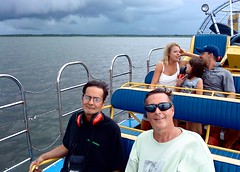
And here’s the boat captain, who sits just in front of the huge, loud propeller.
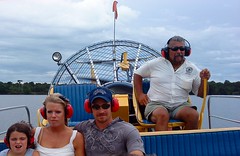
We left the dock as a scary-looking storm gathered on the opposite shore of the lake.

This was both good and bad. It was good because the heavy cloud cover kept the temperature down, with no chance of sunburn. We found out why it was bad a little later.
The captain pushed off from the dock (airboats don’t have reverse), and we slid out into the lake. We hugged the shore for a short distance, and then the captain swung the boat to the left, facing a small channel about 5 feet wide. I couldn’t believe he was going to try and squeeze our big airboat through that gap, but the boat slipped in like magic, into a little hidden backwater channel. If you look closely, you can see a heron, startled by our arrival.
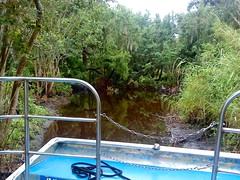
The captain gunned the engine and nimbly spun the boat 90 degrees on its axis, and then motored slowly through the meandering channel. We saw several small alligators and annoyed some more birds, before emerging from the vegetation into the main body of the lake. The captain hit the throttle, and we sped quickly across the surface of the lake, our teeth clacking as we jittered over the washboard-like waves.
On the other side of the lake, we cruised through some more small channels, and saw several alligators.
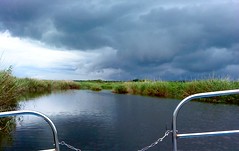
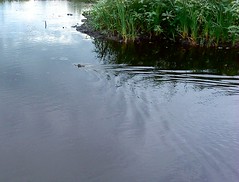
The captain then told us something I didn’t know. When DisneyWorld was constructed in the late sixties, any alligators that were found had to be relocated, so they dumped them all in Lake Jesup.
As we returned from our trip, two veils of rain descended from the clouds in front of us. The airboat captain sped forward, attempting to thread the needle between them, but the two curtains closed on us as we headed for shore. When you’re travelling at 35 or 40 miles an hour, raindrops feel like someone is throwing nuts and bolts at your face. The captain stopped the boat and grabbed some tarps from a hatch. We covered ourselves and made it back to the dock, soaked from the rain, but giddy from the experience.
So I took my brother to do something I’ve wanted to do since I moved to Florida in 1995: an airboat ride on Lake Jesup, which is widely regarded as the most alligator-infested lake in Central Florida.
For those of you who might not know about airboats, they are wide, flat-bottomed boats (usually aluminum) with a big automotive or aircraft engine spinning an aircraft-like propeller mounted above the water on the back of the boat. The thrust of the propeller drives the boat forward, and it’s capable of travelling at high speed, through an inch of water, or even across dry land, if necessary. This makes them ideal for swampy or marshy areas.
Here we are on the boat.

And here’s the boat captain, who sits just in front of the huge, loud propeller.

We left the dock as a scary-looking storm gathered on the opposite shore of the lake.

This was both good and bad. It was good because the heavy cloud cover kept the temperature down, with no chance of sunburn. We found out why it was bad a little later.
The captain pushed off from the dock (airboats don’t have reverse), and we slid out into the lake. We hugged the shore for a short distance, and then the captain swung the boat to the left, facing a small channel about 5 feet wide. I couldn’t believe he was going to try and squeeze our big airboat through that gap, but the boat slipped in like magic, into a little hidden backwater channel. If you look closely, you can see a heron, startled by our arrival.

The captain gunned the engine and nimbly spun the boat 90 degrees on its axis, and then motored slowly through the meandering channel. We saw several small alligators and annoyed some more birds, before emerging from the vegetation into the main body of the lake. The captain hit the throttle, and we sped quickly across the surface of the lake, our teeth clacking as we jittered over the washboard-like waves.
On the other side of the lake, we cruised through some more small channels, and saw several alligators.


The captain then told us something I didn’t know. When DisneyWorld was constructed in the late sixties, any alligators that were found had to be relocated, so they dumped them all in Lake Jesup.
As we returned from our trip, two veils of rain descended from the clouds in front of us. The airboat captain sped forward, attempting to thread the needle between them, but the two curtains closed on us as we headed for shore. When you’re travelling at 35 or 40 miles an hour, raindrops feel like someone is throwing nuts and bolts at your face. The captain stopped the boat and grabbed some tarps from a hatch. We covered ourselves and made it back to the dock, soaked from the rain, but giddy from the experience.
Saturday, July 3, 2010
Kennedy Space Center, Part 3
From the Apollo/Saturn V Center, we took another bus to the International Space Station building. My brother and I avoided the “space program propaganda film” by entering through a side door. The International Space Station exhibit consists of walk-through mockups of the modules that make up the space station. Each module is about the size of a cargo container, but cylindrical. There’s a central corridor, flanked on either side by standard-sized equipment bays. Everything on the space station must fit into one of these bays, including the bathroom.

I was amused by this bay, which contained only a window, prominently labeled.
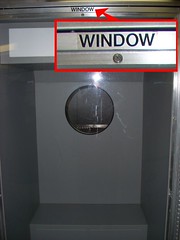
Other bays contained computer equipment, science experiments and life support gear.

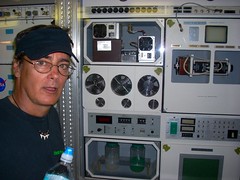
In one module, there was a refrigerator, a freezer and a galley, each fitted into the equipment bays. The space station modules all had a dreadful gray sameness about them that I found depressing.
After leaving the International Space Station exhibit, we caught the bus back to the visitor’s complex, and we walked over to what they call the “rocket garden.” This exhibit consists of numerous launch vehicles from the early days of the space program.
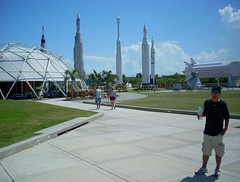
After visiting the Apollo/Saturn V Center, the collection of Mercury and Gemini-era rockets seemed ridiculously dinky and unimpressive. They looked like projects constructed by a few hobbyists in someone's back yard, which they planned to shoot off at Burning Man. It was difficult to imagine what technical achievements they represented, the army of scientists that produced them, and the massive audience that watched every launch.
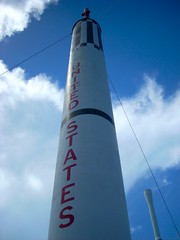

I couldn’t help but notice the corrosion on one of the rockets.
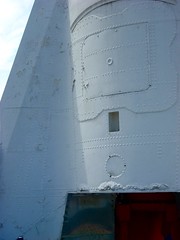
Nearby was a Saturn 1B, the smaller cousin of the massive Saturn V.
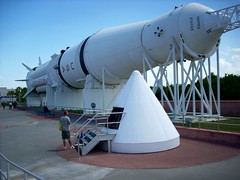
For my brother, the big moment came when we stumbled upon this F-1 engine from the Saturn V. He stood, mesmerized by its size and complex system of pipes and conduits, wishing he could take it home, mount it in a big aluminum tube and shoot it off at Burning Man.


I was amused by this bay, which contained only a window, prominently labeled.

Other bays contained computer equipment, science experiments and life support gear.


In one module, there was a refrigerator, a freezer and a galley, each fitted into the equipment bays. The space station modules all had a dreadful gray sameness about them that I found depressing.
After leaving the International Space Station exhibit, we caught the bus back to the visitor’s complex, and we walked over to what they call the “rocket garden.” This exhibit consists of numerous launch vehicles from the early days of the space program.

After visiting the Apollo/Saturn V Center, the collection of Mercury and Gemini-era rockets seemed ridiculously dinky and unimpressive. They looked like projects constructed by a few hobbyists in someone's back yard, which they planned to shoot off at Burning Man. It was difficult to imagine what technical achievements they represented, the army of scientists that produced them, and the massive audience that watched every launch.


I couldn’t help but notice the corrosion on one of the rockets.

Nearby was a Saturn 1B, the smaller cousin of the massive Saturn V.

For my brother, the big moment came when we stumbled upon this F-1 engine from the Saturn V. He stood, mesmerized by its size and complex system of pipes and conduits, wishing he could take it home, mount it in a big aluminum tube and shoot it off at Burning Man.

Thursday, July 1, 2010
Kennedy Space Center, Part 2
After viewing the launch complex, we boarded the bus again. This time, the bus took us to the Apollo/Saturn V Center, which is a long building about 4 stories tall. The bus dropped us in front of a pair of double doors, where we waited in the heat. Eventually, the doors opened, and everyone shuffled into a room with no seats, and we were forced to stand and endure what I can only call a “space program propaganda film.”
Once the film ended, we were herded through another set of doors into another room with no seats. In this room, there was a display of sixties-era control consoles from Apollo Mission Control, all of which were off – a mausoleum full of long-dead electronics.

Then, another space program propaganda film started. To my amazement, someone had wired up all of those consoles, which came to life with blinking lights and tiny black-and-white monitors.

However, once that film ended, I vowed not to stand through another one. Sure enough, if you look around before going in to an exhibit, you’ll find an entrance that bypasses the movie.
The doors finally opened, and we were admitted to the most awe-inspiring exhibit I have ever seen. Suspended horizontally above our heads was a gigantic Saturn V rocket. It’s as tall as a 36-story building. Each of these main engines is over 12 feet across.

My brother broke into a huge smile, thrilled and delighted.
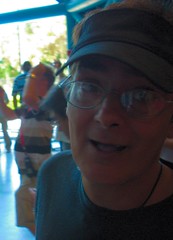
We walked, gaping in wonder, down the length of the enormous machine. It was broken into stages, so that you could see each component of the launch vehicle in its entirety.
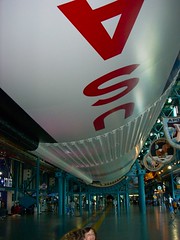
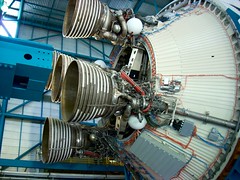
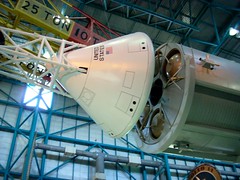
NASA clearly had some help with this exhibit, which was world-class. The presentation of the Saturn V was perfect, and the primary display was surrounded by side exhibits that would appeal to all kinds of audiences. I was intrigued by the display of things designed in the early stages of the space program, such as this helmet with multiple visors, and a spacesuit made like a suit of armor.
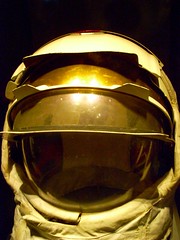

Compare that suit with this more contemporary Apollo mission spacesuit.

And there was this display of plaster casts of the hands of three Apollo astronauts, used to make custom-fitted gloves.
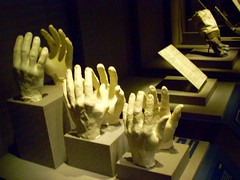
Nearby was the Apollo 14 command module, still scorched by re-entry 39 years ago.
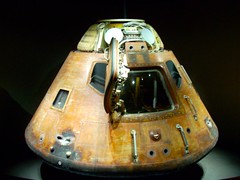
And the inside of a Lunar Excursion Module.
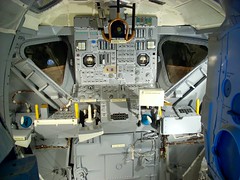
The big exhibit for me was an actual sliver of moon rock that you could touch.
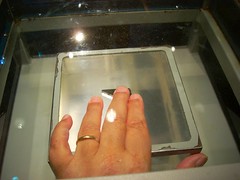
If you go to Kennedy Space Center, I recommend saving the Apollo/Saturn V Center for last. Once you’ve seen it, everything else seems lame by comparison, as you’ll learn in my next post.
Once the film ended, we were herded through another set of doors into another room with no seats. In this room, there was a display of sixties-era control consoles from Apollo Mission Control, all of which were off – a mausoleum full of long-dead electronics.

Then, another space program propaganda film started. To my amazement, someone had wired up all of those consoles, which came to life with blinking lights and tiny black-and-white monitors.

However, once that film ended, I vowed not to stand through another one. Sure enough, if you look around before going in to an exhibit, you’ll find an entrance that bypasses the movie.
The doors finally opened, and we were admitted to the most awe-inspiring exhibit I have ever seen. Suspended horizontally above our heads was a gigantic Saturn V rocket. It’s as tall as a 36-story building. Each of these main engines is over 12 feet across.

My brother broke into a huge smile, thrilled and delighted.

We walked, gaping in wonder, down the length of the enormous machine. It was broken into stages, so that you could see each component of the launch vehicle in its entirety.



NASA clearly had some help with this exhibit, which was world-class. The presentation of the Saturn V was perfect, and the primary display was surrounded by side exhibits that would appeal to all kinds of audiences. I was intrigued by the display of things designed in the early stages of the space program, such as this helmet with multiple visors, and a spacesuit made like a suit of armor.


Compare that suit with this more contemporary Apollo mission spacesuit.

And there was this display of plaster casts of the hands of three Apollo astronauts, used to make custom-fitted gloves.

Nearby was the Apollo 14 command module, still scorched by re-entry 39 years ago.

And the inside of a Lunar Excursion Module.

The big exhibit for me was an actual sliver of moon rock that you could touch.

If you go to Kennedy Space Center, I recommend saving the Apollo/Saturn V Center for last. Once you’ve seen it, everything else seems lame by comparison, as you’ll learn in my next post.
Subscribe to:
Posts (Atom)
